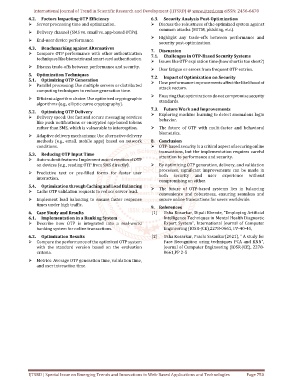Page 760 - Emerging Trends and Innovations in Web-Based Applications and Technologies
P. 760
International Journal of Trend in Scientific Research and Development (IJTSRD) @ www.ijtsrd.com eISSN: 2456-6470
4.2. Factors Impacting OTP Efficiency 6.3. Security Analysis Post-Optimization
Server processing time and optimization. Discuss the robustness of the optimized system against
common attacks (MITM, phishing, etc.).
Delivery channel (SMS vs. email vs. app-based OTPs).
Highlight any trade-offs between performance and
End-user device performance.
security post-optimization.
4.3. Benchmarking against Alternatives
7. Discussion
Compare OTP performance with other authentication
7.1. Challenges in OTP-Based Security Systems
techniques like biometric and smart card authentication.
Issues like OTP expiration time (how short is too short?)
Discuss trade-offs between performance and security.
User fatigue or errors from frequent OTP entries.
5. Optimization Techniques 7.2. Impact of Optimization on Security
5.1. Optimizing OTP Generation How performance improvements affect the likelihood of
Parallel processing: Use multiple servers or distributed attack vectors.
computing techniques to reduce generation time.
Ensuring that optimizations do not compromise security
Efficient algorithm choice: Use optimized cryptographic standards.
algorithms (e.g., elliptic curve cryptography).
7.3. Future Work and Improvements
5.2. Optimizing OTP Delivery
Exploring machine learning to detect anomalous login
Delivery speed: Use fast and secure messaging services
behavior.
like push notifications or encrypted app-based tokens
rather than SMS, which is vulnerable to interception. The future of OTP with multi-factor and behavioral
biometrics.
Adaptive delivery mechanisms: Use alternative delivery
methods (e.g., email, mobile apps) based on network 8. Conclusion
conditions. OTP-based security is a critical aspect of securing online
transactions, but the implementation requires careful
5.3. Reducing OTP Input Time attention to performance and security.
Auto-submit features: Implement auto-detection of OTP
on devices (e.g., reading OTP from SMS directly). By optimizing OTP generation, delivery, and validation
processes, significant improvements can be made in
Predictive text or pre-filled forms for faster user
both security and user experience without
interaction.
compromising on either.
5.4. Optimization through Caching and Load Balancing
The future of OTP-based systems lies in balancing
Cache OTP validation requests to reduce server load.
convenience and robustness, ensuring seamless and
Implement load balancing to ensure faster response secure online transactions for users worldwide.
times under high traffic.
9. References
6. Case Study and Results [1] Usha Kosarkar, Dipali Bhende, “Employing Artificial
6.1. Implementation in a Banking System Intelligence Techniques in Mental Health Diagnostic
Describe how OTP is integrated into a real-world Expert System”, International Journal of Computer
banking system for online transactions. Engineering (IOSR-JCE),2278-0661, PP-40-45,
6.2. Optimization Results [2] Usha Kosarkar, Prachi Sasankar(2021), “ A study for
Compare the performance of the optimized OTP system Face Recognition using techniques PCA and KNN”,
with the standard version based on the evaluation Journal of Computer Engineering (IOSR-JCE), 2278-
criteria. 0661,PP 2-5
Metrics: Average OTP generation time, validation time,
and user interaction time.
IJTSRD | Special Issue on Emerging Trends and Innovations in Web-Based Applications and Technologies Page 750

